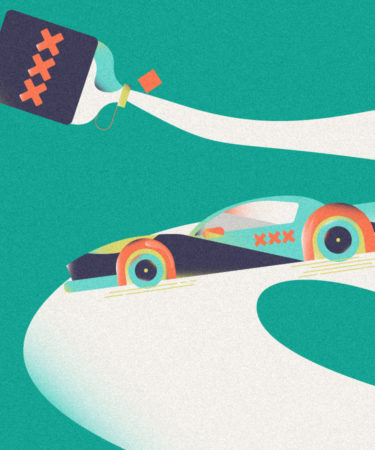After the slow creep of the Temperance Movement throughout the 18th and early 19th centuries, Prohibition officially launched nationwide in 1920. Around the same time, the country faced another seismic shift in American culture: the advent of the automobile.
In the 1920s and ‘30s, city residents’ demand for counterfeit booze and the near-simultaneous rise of the Model T Ford created a boon in the black-market booze business. While developing the market for homemade Appalachian spirits, moonshiners and bootleggers inadvertently created the stock-car racing sport we now know as NASCAR.
To transport their liquor from rural forest hideouts to cities, moonshiners employed runners, or drivers who hauled hooch in secret in the middle of the night. Avoiding government agents required intense precision, speed, and unparalleled maneuvers, like the 180-degree “bootleg turn.” The freewheeling runners became experts behind the wheel, as well as under the hood, re-outfitting and retrofitting the stock Ford V-8 to be faster and lighter, and its frame and interior capable of hiding lots of liquor.
Replacement shocks and springs “safeguard[ed] the jars containing the hooch from breaking on bumpy mountain roads. The seats in the back were usually removed so more booze could fit. And high-powered engines gave the cars extra speed to outrun any cops and tax agents along the route,” Smithsonian Magazine reports.
In other words, they were making race cars. Hardworking hooch haulers had to practice their moves and routes, and began racing one another for sport. As these friendly competitions spread throughout the Southeast, former driver Big Bill France saw an opportunity to codify and promote what had become a regional touring racing series.
In January 1947, France established the National Championship Stock Car Circuit (NCSCC) to standardize rules, establish point systems, and provide better prizes for drivers. In December 1947, an NCSCC convention re-established and renamed the NSCC the National Association for Stock Car Auto Racing (NASCAR).
The crossover didn’t end there. Legendary moonshiner and NASCAR hall of famer Junior Johnson operated a family still, and was jailed for nearly a year in 1956. He later received a presidential pardon from Ronald Reagan.
In 2007, Johnson partnered with North Carolina’s Piedmont Distillers to release Junior Johnson’s Midnight Moon Original, a packaged, legal moonshine based on his family recipe. Sales were so successful that the distillery expanded twice over the next five years. A fruit-infused line was served at the 2012 Grammys.
In 2009, Dean Combs, five-time champion of NASCAR’s compact-car touring series, was charged with operating a homemade still. When the Wilkes County Sheriff’s Office (literally) blew up his operation, an agent told the Richmond Times-Dispatch, “You couldn’t ask for a nicer fellow.”
NASCAR launched its first official moonshine in 2018 with Tennessee’s Sugarlands Distilling Co., called Sugarlands Shine. Fans can sign up for the “Shine Runners Club” to receive members-only discounts on ‘shine and swag, and can win prizes at NASCAR races.
Other alcohol companies are understandably hesitant to partner with an automotive sport.
A representative from Belle Isle Moonshine of Richmond, Va., told VinePair in an email that “moonshine’s history as it relates to NASCAR isn’t [Belle Isle’s] specialty.” Up and down the Southeast, white-lightning distillers from Belmont Farm Distillery in Culpeper, Va., to Asheville Distilling Co. in North Carolina, to Prichard’s Distillery in Kelso and Nashville, Tenn., all failed to return requests for comment about possible NASCAR connections to the moonshines they produce.
Mum’s the word for some distillers. Historically, however, from state sheriffs to Shine Runners Club members, the spirit and sport remain inextricably linked.
